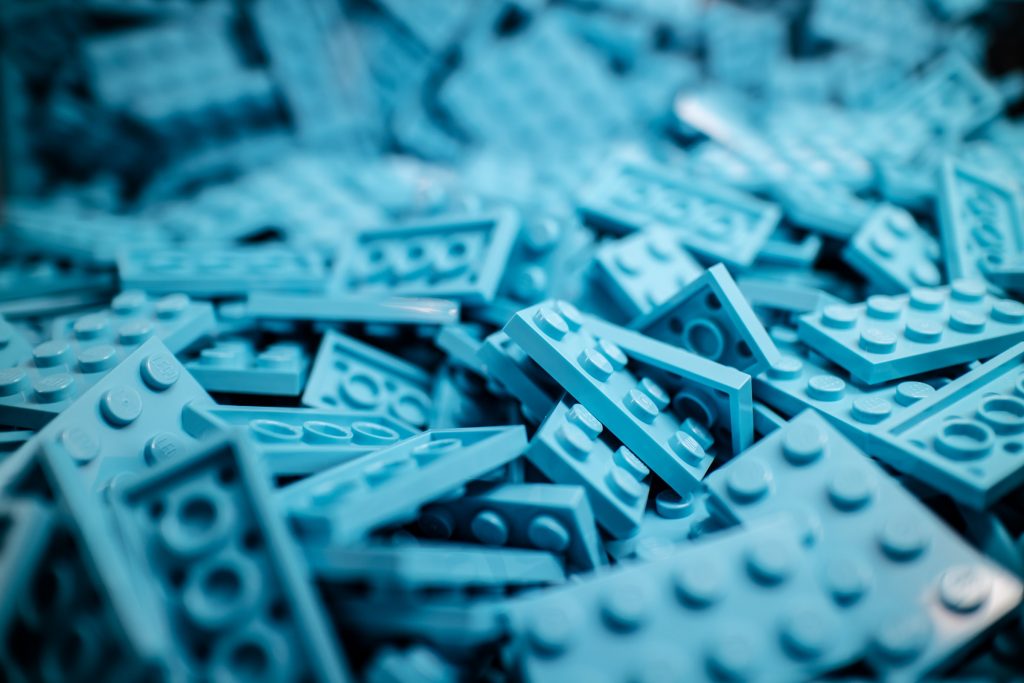Lecture by Susanna Edwards
How Do We Generate Ideas?
Ideas are a very personal thing – everyone has a different manner of thinking, a different way of putting ideas together. When examining how I think this week I’ve come back to my remarks from last week, a’bout my magpie brain. I feel that I do a lot of my idea generation in my unconscious mind, it picks up disparate “shiny” objects, then creates connections between them in an idea or spark, which either lazily swims up to my attention, or erupts in a furious burst. Smaller sparks join together, and my active mind can take these and link them together in different ways, turning them this way and that until they link up into an idea.
I found Daniel Kahneman’s theory of thinking resonated very much – during Susanna’s lecture she asked us to stop and attempt a multiplication problem. (Edwards 2020) I duly did, pausing the video and working the math problem out on paper. The math was quite easy for me, but what I took note of is how it felt. I could feel my focus shifting and my mind pulling up old pathways. I did not have to think about how to solve the problem, I had a framework of steps to rely on already there that came when they were needed. How we build these frameworks and what we put in our mental banks, is a necessary step to design, one we may not even realise is happening. Maria Popova spoke about creativity like Lego, the more pieces, the more colours we have access to, the broader and more expansive our thoughts. (Popova 2011) Actively seeking out new experiences, experimenting and engaging in life will fuel creative expression.
Popova espouses the combinatorial creative theory, or networked knowledge. “…the idea that creativity is combinatorial, that nothing is entirely original, that everything builds on what came before, and that we create by taking existing pieces of inspiration, knowledge, skill and insight that we gather over the course of our lives and recombining them into incredible new creations.” (Popova 2011)
This resonated on a deep level with me, the concept of combining things, taking them apart, trying new iterations of the same idea until something clicks into place. Although I claim most of my idea generation occurs in my subconscious, the real creative effort is how I combine these sparks or sub-ideas until it builds into something of value. Popova says that “…curiosity without direction can be a taxing and ultimately unproductive endeavor. Choice is how we tame and channel and direct our curiosity, where we choose to allocate our time and energy, and ultimately, what we choose to pay attention to.” (Popova 2011) Idea generation is necessary, but it is only the first step, the curation of those ideas is equally important. In my notes this week I remarked on my tendency to overthink. Overthinking paralyses creativity, taking an idea down so many different theoretical avenues that I am unable to do anything at all. It is far more helpful for me to simply begin, once I begin working the ideas filter up and into my conscious brain. The choices I make using those ideas are where the design process starts.
I must admit that I had not given much thought to different design processes before this week. Aside from very simple activities such as brainstorming, making lists or free association, I generally just start working and muddle through until I have something worthwhile. I scribbled a quick sketch of how my ideas generally develop, below.

Chaos -> Direction -> Rumination -> Resolution
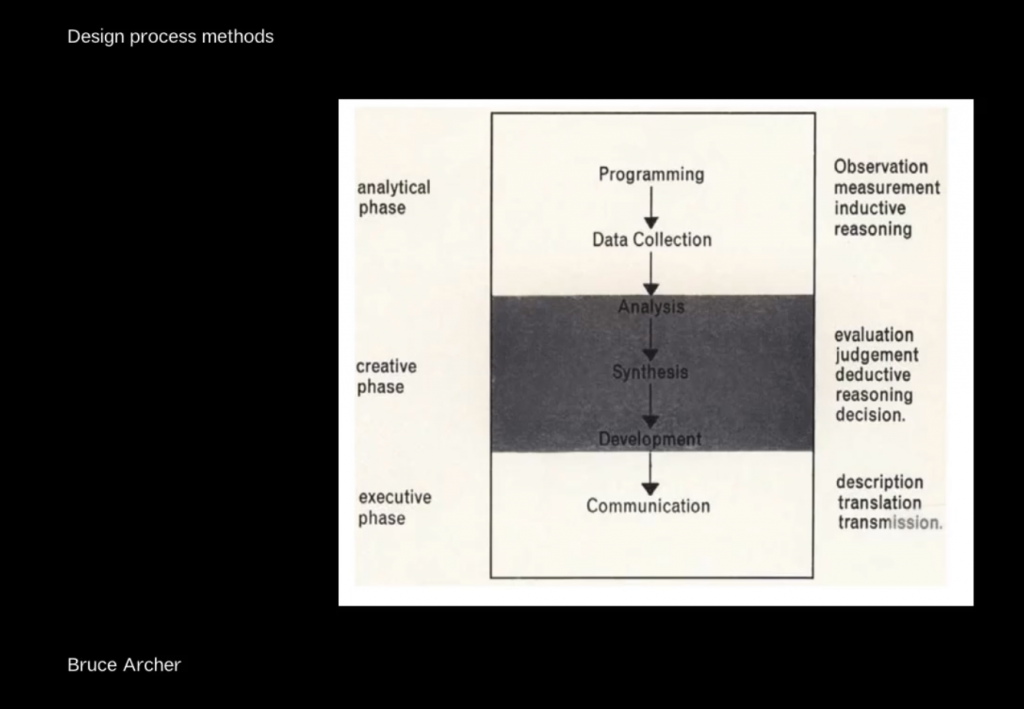
After researching different design systems, I realised that I do indeed follow a system, I had just never sat down and recognised that is what I was doing. While watching the lecture this week, I had originally thought that Bruce Archer’s design process method was cold and methodical. Trying to define and formalise intuitiveness or turning the design process into a restrictive science. As I’ve been thinking about my own way of working, I’ve found that I recognise my own process within it. This was surprising to me. Every project starts with a problem or question. I almost never have a client with a well thought out brief, they come to me with an idea of what they want, and either no clue how to get there, or (worse) a very strong idea of how to get there without an understanding of what is possible.
The first step then is to Question – What are you trying to achieve? What do you want vs. what do you need? What assets do you already have? What feeling are you trying to evoke? How long is it? What size? What about colours? Paper options? Do you need artwork? Illustrations, a logo, an entire branding package? Do you have branding guidelines already that I need to stay within? How open are you to new ideas? etc., etc.
After asking a range of questions and making notes, you Define the problem and repeat it back to the client. I don’t write a formal brief, but that is effectively what is happening, making sure I have a good grasp on the question, and that the client and I are on the same page. This step often introduces new options, as I explain limitations or the availability of solutions they did not know existed. As I mainly work with print clients, explaining very real boundaries is important, but also knowing how to break those boundaries or work around them helps immensely. This stage can be frustrating, explaining that no, you can not print a 501 page book at 6pt type and stitch trim it. A very small photograph will not be crisp blown up to 3ft tall, a landscape photo will need to be cropped to fit this portrait space, and that yes, I am bound by the laws of physics. This is also an exciting time as I can often open a whole new range of possibility up to a client, helping them work out a scope for their project, and often sparking new avenues and further projects for the future.
Once I have a good grasp of the project, I start Researching. I look at similar projects, completely dissimilar projects, I gather inspiration from different points of view, make sketches and start letting ideas percolate. Then I start working. I often feel like I have no ideas, no inspiration, and that I can not possibly come up with anything good for a project. A common issue with creative endeavours is the fear of the blank page. Every sketchbook I’ve ever owned has had a blank first page. It is intimidating, I feel like the first page should be special and that nothing I put on it would be good enough. My solution is to skip the first page – this tricks my brain and short circuits the fear entirely. The first page may be terrifying, but the second page is fine! I can scribble on it, make notes or doodles, draw a terrible drawing.
Giving myself the freedom to produce work without worrying if it is “good” lets me move onto the next stage – Iterations. Putting one line down makes me want to put the next down. Seeing both of them together lets those tiny sparks of ideas start flying. “What if I put this here? That is interesting, maybe I can move it over there? Oh! What about this!” I tend to work messily, bits and pieces flying off the pasteboard, scraps of paper with flashes of inspiration jotted on them. The next stage is a loop of Refinement and Feedback. Ideas have been generated, too many ideas, and I need to sift through them and begin choosing what is necessary, what is good, whittling away the excess until I have a solution that is clear. At this point I seek out feedback , other points of view are incredibly important. My intention and understanding of a project has grown as I’ve created it, I need an outside perspective to bring me new questions and test that understanding. Once I have a few solid options I present these to the client, which starts a final loop of Feedback and Refinement, ultimately leading to Approval. My entire process feels like a movement from darkness into the light, or organising chaos. It is not as linear as Archer’s process, or as tidy. Still, I made a flowchart of the process.
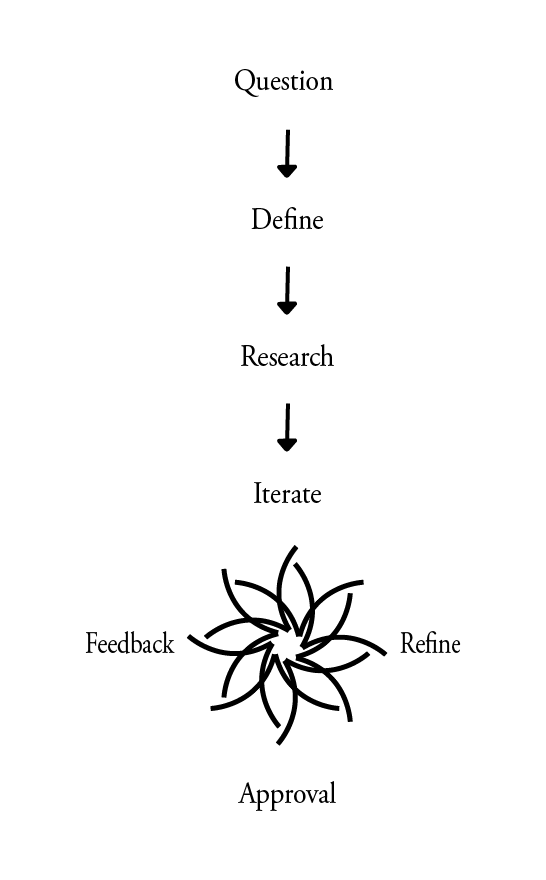
This was too tight, too tidy, and didn’t feel like my way of thinking. I flipped it on its axis, and added a more circular movement to the feedback/refinement process, with the mandala aspect given more emphasis.

Then I came across Damien Newman’s Design Squiggle.
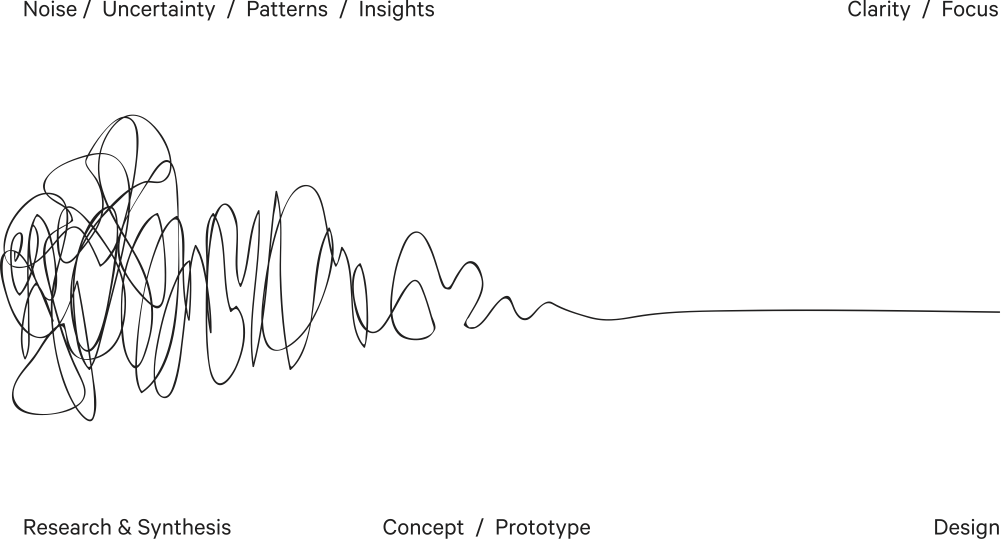
Such a simple and evocative drawing! This has clear parallels to my earlier quick sketch and felt much more comfortable to me. I’m not clean and tidy, I’m messy and chaotic and refine work as I go, until it is clear and meets a brief. I started thinking about how I work when it is not to for a brief, what do I do when I am creating something for myself, just drawing or creating for the sake of it? I have a real love of printmaking and decided to pull some supplies out from storage and have a go at monotypes.

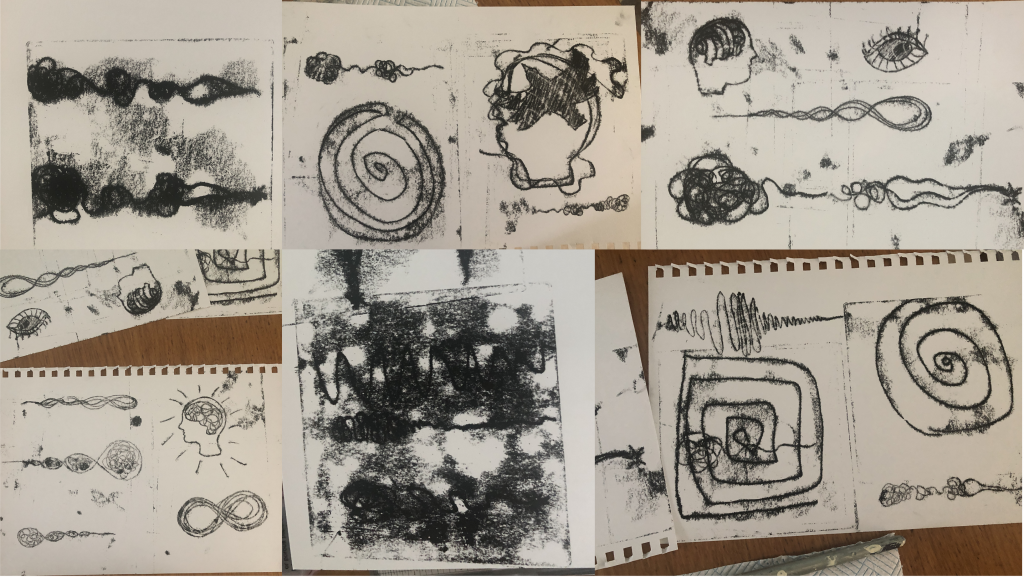
I only had a small plate to ink up, so I started layering the prints, lifting the paper and repositioning it, drawing on top of other prints, drawing and redrawing similar concepts. Transfer monotypes result in a single print, full of surprise and accidental markings. I started with very similar ideas to my first quick sketch, scribbly loops of confusion refining and looping back to a tangled snarl before joining and smoothing out. Eventually this teased into looping figure eights, twisting and joining, whorls resembling a seashell emerging from the ink.

Summary
This week felt like my design process – complicated and messy, needing refinement and multiple iterations before coalescing into something more tangible.
I’m very glad I ventured into traditional media, it felt wonderful to get my hands dirty and trust in the process. Monotypes have a lovely sense of discovery and randomness. Every print you pull is a unique experience, marks transfer from how you handle the paper as well as your from drawing tool and can be layered and worked into again and again.
Freedom and experimentation are very appealing, and this course has been a catalyst to rediscovering interests I have been neglecting. I found I resisted trying to classify my thought process or define myself, which is ironic as my worklife is relatively prescriptive and dealing with clients has definite steps and a process. Perhaps that is why I struggled with it – I’m looking to shake those processes up and trust my own instincts and work more. I did very strongly resonate with the combinatorial creative theory, and am constantly trying to broaden my horizons.
References
BARLOW, Andrew. 2011. “RSA Animate – The Divided Brain.” The RSA [online]. Available at: https://www.thersa.org/video/animates/2011/10/rsa-animate—the-divided-brain [accessed 21 Oct 2020].
EDWARDS, Susanna. 2020. Week 5 Thoughts on Ideas [lecture]. GDE710 for MA Graphic Design. Falmouth: Falmouth University 2020 [Accessed 23 Oct 2020]
IKER URTEAGA. 2017. “Blue Building Block Lot.” Unsplash.com [online]. Available at: https://unsplash.com/photos/TL5Vy1IM-uA [accessed 27 Oct 2020].
KAHNEMAN, Daniel. 2012. Thinking, Fast and Slow. London: Penguin.
MORTENSEN, Ditte Hvas. 2020. “Three Ideation Methods to Enhance Your Innovative Thinking.” The Interaction Design Foundation [online]. Available at: https://www.interaction-design.org/literature/article/three-ideation-methods-to-enhance-your-innovative-thinking [accessed 23 Oct 2020].
NEWMAN, Damien. 2019. “The Design Squiggle.” Thedesignsquiggle.com [online]. Available at: https://thedesignsquiggle.com/ [accessed 27 Oct 2020].
POPOVA, Maria. 2011. “Networked Knowledge and Combinatorial Creativity.” Brain Pickings [online]. Available at: https://www.brainpickings.org/2011/08/01/networked-knowledge-combinatorial-creativity/ [accessed 17 Oct 2020].
THE SCHOOL OF LIFE. 2014. “On Exercising the Mind -.” The School of Life Articles [online]. Available at: https://www.theschooloflife.com/thebookoflife/exercise-for-the-mind/ [accessed 21 Oct 2020].
THE SCHOOL OF LIFE. 2017. “Thinking Too Much; and Thinking Too Little -.” The School of Life Articles [online]. Available at: https://www.theschooloflife.com/thebookoflife/thinking-too-much-and-thinking-too-little/ [accessed 21 Oct 2020].
